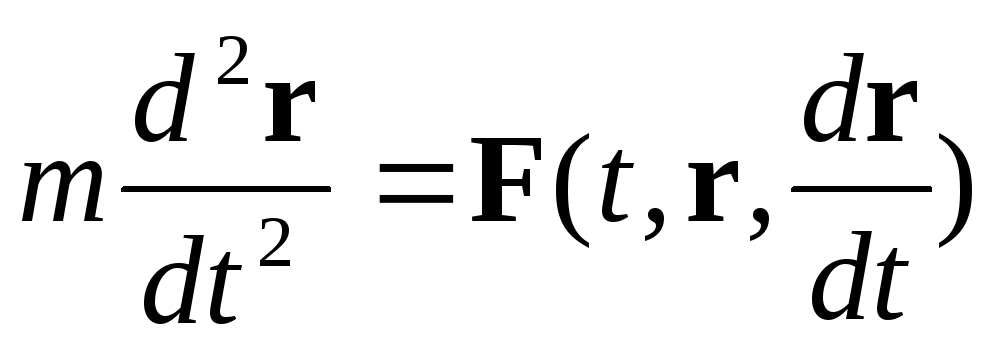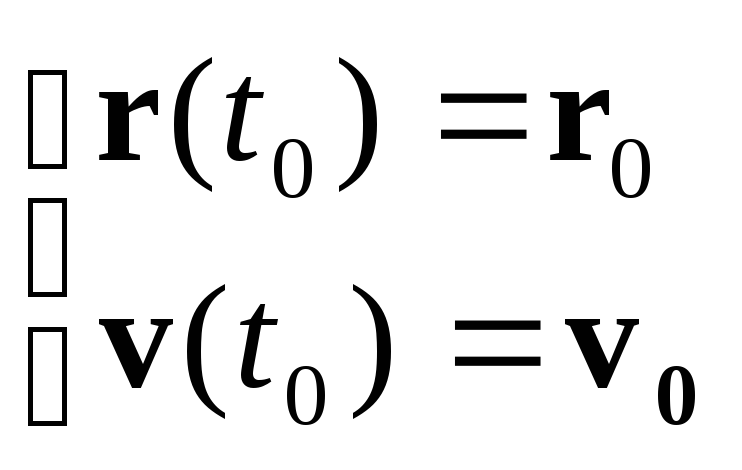4. Interaction of bodies
Phone interaction. Experience shows that when bodies (or systems of bodies) approach each other, the nature of their behavior changes. Since these changes are mutual, the bodies are said to interact with each other . When the bodies are separated over very large distances (to infinity), all currently known interactions disappear.
Gallileo was the first to give the correct answer to the question of what kind of movement is characteristic of free
(i.e. non-interacting bodies). Contrary to the then existing opinion that free bodies “tend” to a state of rest (), he argued that in the absence of interaction, the bodies are in a state of uniform motion (  ), which includes rest as a special case.
), which includes rest as a special case.
Inertial reference systems. Within the framework of the formal mathematical approach implemented in kinematics, Galileo's statement looks meaningless, since a motion that is uniform in one frame of reference can turn out to be accelerated in another, which is "no worse" than the original one. The presence of interaction allows us to single out a special class of reference systems in which free bodies move without acceleration (in these systems, most of the laws of nature have the simplest form). Such systems are called inertial.
All inertial systems are equivalent to each other, in any of them the laws of mechanics manifest themselves in the same way. This property was also noted by Galileo in his principle of relativity: n It is impossible to establish whether it is at rest or uniformly moving in a closed (ie, not communicating with the outside world) frame of reference, and no mechanical experience can determine whether it is at rest or moving uniformly. Any frame of reference that moves uniformly relative to inertial is also inertial.
There is a fundamental difference between inertial and non-inertial frames of reference: an observer located in a closed system is able to establish the fact of movement with the acceleration of the latter, “without looking out” (for example, when an airplane accelerates, passengers feel that they are “pressed” into their seats). Later it will be shown that in non-inertial systems the geometry of space ceases to be Euclidean.
Newton's laws as the basis of classical mechanics. The three laws of motion formulated by I. Newton make it possible in principle to solve the main task of mechanics , i.e. according to the known initial position and speed of the body, determine its position and speed at an arbitrary moment in time.
Newton's first law postulates the existence of inertial frames of reference.
Newton's second law States that in inertial systems, the acceleration of the body is proportional to the appliedstrength , a physical quantity that is a quantitative measure of the interaction. The magnitude of the force characterizing the interaction of bodies can be determined, for example, by the deformation of an elastic body, additionally introduced into the system so that the interaction with it completely compensates for the original one. The coefficient of proportionality between force and acceleration is called body weight :
(1) F= m a
Under the action of the same forces, bodies with a larger mass acquire smaller accelerations. Massive bodies during interaction change their speeds to a lesser extent, “trying to preserve the natural motion by inertia”. It is sometimes said that mass is measure of inertia of bodies (Fig. 4_1).
The classical properties of mass include 1) its positivity (bodies acquire accelerations in the direction of the applied forces), 2) additivity (the mass of a body is equal to the sum of the masses of its parts), 3) independence of the mass from the nature of motion (for example, from speed).
third law states that the interactions of both objects experience the actions of forces, and these forces are equal in magnitude and oppositely directed.
Types of fundamental interactions. Attempts to classify interactions led to the idea of isolating the minimum set fundamental interactions , which can be used to explain all the observed phenomena. With the development of natural science, this set has changed. In the course of experimental studies, new natural phenomena were periodically discovered that did not fit into the accepted fundamental set, which led to its expansion (for example, the discovery of the structure of the nucleus required the introduction of nuclear forces). Theoretical understanding, on the whole, striving for a single, most economical description of the observed diversity, repeatedly led to “grand unifications” of outwardly completely dissimilar natural phenomena (Newton realized that the fall of an apple and the movement of planets around the Sun are the results of the manifestation of gravitational interactions, Einstein established the unified nature of electrical and magnetic interactions, Butlerov refuted the assertions about the different nature of organic and inorganic substances).
A set of four types of fundamental interactions is currently accepted:gravitational, electromagnetic, strong and weak nuclear. All the others known to date can be reduced to a superposition of the listed ones.
Gravitational interactions are due to the presence of mass in bodies and are the weakest of the fundamental set. They dominate at distances of cosmic scales (in the mega-world).
Electromagnetic interactions due to a specific property of a number of elementary particles, called electric charge. They play a dominant role in the macro and micro worlds up to distances exceeding the characteristic dimensions of atomic nuclei.
Nuclear interactions play a dominant role in nuclear processes and appear only at distances comparable to the size of the nucleus, where the classical description is obviously inapplicable.
At present, it has become very popular to talk about biofield , with the help of which a number of not very reliable experimentally established natural phenomena associated with biological objects is “explained”. Serious attitude to the concept of a biofield depends on what specific meaning. Embedded in this term. If the concept of a biofield is used to describe interactions involving biological objects that are reduced to four fundamental ones, such an approach does not raise fundamental objections, although the introduction of a new concept to describe “old” phenomena contradicts the generally accepted tendency in natural science to minimize the theoretical description. If, however, a biofield is understood as a new type of fundamental interactions that manifests itself at the macroscopic level (the possibility of the existence of which is obviously pointless to deny a priori), then such far-reaching conclusions require very serious theoretical and experimental justifications made in the language and methods of modern natural science, which until have not been presented to date.
Newton's laws and the main task of mechanics. To solve the main problem of mechanics (determining the position of the body at an arbitrary moment of time from the known initial position and speed), it is enough to find the acceleration of the body as a function of time a(t). This problem is solved by Newton's laws (1) under the condition of known forces. In the general case, the forces can depend on the time, position and speed of the body:
(2) F=F(r,v, t) ,
those. To find the acceleration of a body, it is necessary to know its position and velocity. The described situation in mathematics is called second order differential equation :
(3)
 ,
,
(4)

The math shows that problem (3-4) in the presence of two initial conditions (position and velocity at the initial moment of time) always has a solution and, moreover, the only one. That. the basic problem of mechanics always has a solution in principle, but it is often very difficult to find it.
Determinism of Laplace. The German mathematician Laplace applied a similar theorem on the existence and uniqueness of a solution to a problem of type (3-4) for a system of a finite number of equations to describe the motion of all particles of the real world interacting with each other and came to the conclusion that it is fundamentally possible to calculate the position of all bodies at any time . Obviously, this meant the possibility of an unambiguous predicted future (at least in principle) and complete determinism (predestination) of our world. The statement made, which is more philosophical than natural scientific in nature, was called determinism of Laplace . If desired, one could draw from it very far-reaching philosophical and social conclusions about the impossibility of influencing the predetermined course of events. The fallacy of this teaching was that atoms or elementary particles (“material points” of which real bodies are composed) do not actually obey the classical law of motion (3), which is true only for macroscopic objects (i.e., those with sufficiently large masses and sizes). Correct from the point of view of today's physics, the description of the movement in time of microscopic objects, which are the atoms and molecules that make up macroscopic bodies, is given by the equations quantum mechanics, , allowing to determine only the probability of finding a particle at a given point, but fundamentally not giving the possibility of calculating the trajectories of motion for subsequent moments of time.



